If you are like me, you don’t have a lot of money to pay a general contractor to manage a big rental property kitchen renovation for you. As an accidental landlord, you know that running the project yourself is tough but it will save you thousands.
Managing a rental property kitchen renovation can be overwhelming. You are faced with many complications and decisions. How much more is a tenant willing to pay for a renovated rental kitchen? Which materials will hold up to tenant abuse? How can I maximize the return on my investment?
This is compounded by the stress of managing contractors and ordering materials while trying to minimize vacancy so you can keep up with the mortgage payments.
To successfully maximize your return on your rental property kitchen renovation you need to know how much you can invest, which materials will give you the most bang for the buck and be a great project manager.
I recently managed my own rental property kitchen renovation and was faced with these questions. Instead of jumping right in, I took some time to prepare in advance. I researched the market to see how much I could increase rent after a full kitchen renovation.
I also looked at my possible exit strategies – continue to hold or sell. This helped me determine the best materials to use to maximize my return.
But I also made a couple of mistakes that you should avoid. More on that in a future article.
In this article, I will show you the process I used to maximize my return on investment for my latest rental property kitchen renovation. Specifically, I will show you how to:
- Set your budget for maximum ROI
- Choose the best materials for durability and appeal
- Calculate a renovation ROI using my case study
How To Set A Rental Property Renovation Budget
 Before you ever pick up a sledgehammer you need to prepare a renovation budget. There are several factors to consider when setting your rental property kitchen renovation budget.
Before you ever pick up a sledgehammer you need to prepare a renovation budget. There are several factors to consider when setting your rental property kitchen renovation budget.
What’s Your Exit Strategy?
What’s your expected holding period? Are you planning to hold this property indefinitely or are you planning to sell it in the next year or two?
If you plan to sell soon do you know your target buyer profile? Are planning to sell the property to an owner-occupant? If so, then you should be budgeting for a more expensive renovation. You will need to choose materials and finishes that appeal to the retail market. Things like solid wood cabinets and stone countertops maybe more appropriate.
However, if you are planning to hold the property indefinitely or sell to another rental property investor, then your budget should include durable but affordable materials. Look for things like luxury vinyl plank flooring and laminate countertops if this is your exit strategy.
CASE STUDY. I am interested in selling this property to an owner occupant in the next year or two. So I opted for higher-end finishes with more durability.
Why renovate a kitchen for an owner-occupant but then rent it to a tenant who won’t appreciate the renovation as much? While I am looking to sell in the near future, I wasn’t prepared to do a 1031 exchange in time for the peak selling season. I didn’t want to be stuck trying to sell the property off-season while trying to buy a 1031 exchange simultaneously. I figured I am better off waiting one year or two.
Side Note – You may also be wondering why I would sell a property with positive cash flow, check out my article about owning rental in a condo association. This is the last of my condos and I hope to be out of the condo association business soon.
What Can You Rent Or Sell The Property For After The Kitchen Renovation?
Now that you know your exit strategy, the next step is to understand how much of a return on investment you can expect to get. Check the local comps to see how much more rent a renovated kitchen commands versus a non-renovated kitchen.
Perform a similar analysis on selling price if you plan to sell the property.
CASE STUDY. In my case, I looked at it both ways because I was planning to rent it out for the next couple of years and then sell to an owner-occupant.
I estimated that I could charge an extra $150 to $200 per month in rent, based on my realtor’s analysis and my own searching,
In addition, the property could sell for an extra $20,000 with the renovated kitchen.
I am confident in this higher selling price because a unit in my building recently sold with a renovated kitchen. I was able to deduce the extra value from the renovated kitchen based on the comps.
PRO TIP – If you do plan to sell your rental soon after a major renovation, be sure to thoroughly screen your next tenants. A tenant who trashes your kitchen renovation will easily destroy any value created in the process.
What Can You Afford?
 You also need to consider what you can afford and your source of capital. If you have been a good Accidental Landlord and saved a sizable cash reserve in anticipation major repairs then you should be in good shape.
You also need to consider what you can afford and your source of capital. If you have been a good Accidental Landlord and saved a sizable cash reserve in anticipation major repairs then you should be in good shape.
If you do pay for the renovation with cash from your reserves be sure to leave enough in case of an emergency. At a minimum, you should maintain a line of credit that you can easily tap into.
However, if you are borrowing to pay for the renovation, then you need to factor in this interest expense into your ROI calculation. This will directly eat into your expected ROI.
For example, if you plan to spend $10,000 on a rental property kitchen renovation and expect be able to charge an extra $100 per month in rent, then your cash ROI would be 12% ($1,200 extra rent / $10,000). But if you are borrowing at 5% interest, then your net ROI is only 7%.
Always Add 10% To Your Budget
This should go without saying but nothing will go as planned. You need to add a buffer of at least 10% to cover the unexpected. You never know what you’ll find until you start ripping out cabinets and opening up walls. Don’t get stuck mid-renovation without the funds to finish the project.
What’s A Good Renovation ROI?

Your target rental property renovation ROI will depend on your personal situation and your next best alternative to this investment.
For our purposes, I’ve assumed that the renovation is necessary so your objective is maximizing the ROI by setting the right budget.
Here are some of the main factors to consider when determining if your planned rental property kitchen renovation is worth the investment:
- Increased Rent
- Increased Equity
- Reduced Maintenance
- Reduced Vacancy
- Attracting Higher Quality Tenants
Increased Rent
The biggest factor in determining your projected ROI. How much more can you expect to collect in rents and for how long will those higher rents last? Higher rents won’t last forever.
A typical kitchen renovation will look “fresh” for the first five to 10 years and then start to look dated and worn. The appliances may need to be replaced in about five years but the rest of the kitchen will probably last about 10 years or so.
Increased Equity
You should also consider the extra equity value your renovation will provide on your investment. If you spent $10,000 on a rental property kitchen renovation and your property appreciated in value by $10,000. Wouldn’t that be a good investment? Now you get the higher rent and your property is worth more. In other words the increased equity paid for the cost of the renovation.
Reduced Maintenance

You don’t need to be a genius to understand that new appliances break down less than older ones. That means fewer service calls and maintenance visits which might just save you hundreds each year for the first couple of years after the renovation.
The same is true for plumbing and electrical issues. Take advantage of the renovation and install a new sink, new GFI outlets and new LED lighting. No more light bulbs to change. Yay!
Higher Quality Tenants
Rentals with recently renovated kitchens (and the higher rent they command) will tend to attract tenants with fewer issues overall in my opinion. This can be priceless really.
Reduced Vacancy
Finally, there is one more thing to consider. The true value of a renovation isn’t just the extra rent or the increased equity. It also cuts down on vacancy time. A renovated property rents quicker. And that saves you money.
If you can rent your apartment in 1 week instead of the normal 2 weeks, it will save you about 2% in Annual Gross Rents every tenant turnover. That’s 2 points of Net Operating Income in your pocket!
CASE STUDY. I budgeted about $17,500 for the renovation with the expectation that I would be able to sell the property for about $20,000 more in the near future. I didn’t want to go above $20,000 in case the market took a sharp downturn before I could sell my property. This budget gave me a nice buffer.
Payback Period?
You will see several investors tell you that you should look to achieve a two-year payback on any improvement. I don’t necessarily agree.
If you invest $10,000 to renovate your rental property kitchen but it earns you $100 more per month in rent. That’s a good investment in my opinion. I will take a 12% return on my cash all day long. Even if it takes over eight years to recoup that cost.
In the example above if you spent the $10,000 on affordable but durable materials such as luxury vinyl plank flooring, your renovated kitchen useful life should be more than eight years.
Some will argue that the extra rent won’t last indefinitely due to tenant wear and tear on your renovated kitchen. This is generally true for appliances. However, it isn’t necessarily true if you choose durable materials for the other big-ticket items such as cabinets, countertops and floors.
The bottom line for me is that as long as the renovation outlasts the payback period and the higher rent is sustainable over this period, the project will payback.
Use An Online Cost Estimator
Are you terrible at estimating how much your new rental property kitchen renovation might cost? Take advantage of the many online resources designed to help you estimate what your project might cost in your area. Home Advisor’s True Cost Tool aggregates costs from real projects and gives you averages for your area.
I compared it to what I actually paid and I found it to be in the ballpark. It’s comprehensive and easy to use.

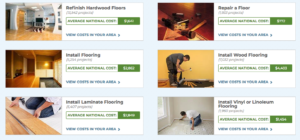

Choose The Best Materials To Maximize Appeal And Durability
You’ve identified your exit strategy and set your budget. Great job! Now it’s time to choose the best materials for your rental property kitchen renovation project.
Maximizing Value
The key to maximizing your rental property renovation ROI is to understand the value equation of renovations. In mathematical terms it looks like this:
Value = Useful Life / Price
In order to get the best value for your renovation, you have to get the most out of it. That means finding the most durable materials you can afford that appeal the most to your target market.
This is true whether you plan to hold on to your rental property or sell it to another investor. It’s usually also true if you plan to sell your rental to a retail buyer. There aren’t too many materials that appeal to homebuyers but don’t last too long. You get what you pay for and most homebuyers want hassle-free living.
Here’s a simple example to illustrate the point.

In the example above, you may be tempted to buy the cheaper cabinets but a closer look reveals that higher priced cabinets are a better value. They cost less per year of useful life. Choosing materials based on this method will maximize your rental property renovation ROI.
Remember, the goal is to make sure your renovation outlasts the Payback period.
Maximizing Appeal
Value is important but it isn’t the only thing you should look at. You need to make sure the materials and finishes you choose are right for your target market. Knowing what your target renter or home buyer values is how you maximize appeal AND return on your investment at the same time.
For example, if you are targeting young families with kids and pets, you might consider adding a fence on the property. An investment of several thousand dollars could easily pay off in a few short years form higher rents, lower turnover, pet rent, etc.).
CASE STUDY: I am planning to target a young first time home buyer looking for a small but affordable place of their own. They are starting to settle down so I expect them to stay home and cook more than my typical renters in this same home. So I decided to upgrade to Quartz countertops and a larger range.

That open space in the picture above is for a full size range. I expect my target home buyer will value (and pay for) a new standard size stove and quartz countertops.
Here are some things you might want to consider when choosing materials and finishes for a renter vs. a homebuyer.
Cabinets
Stock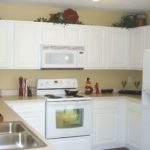 | Semi-Custom | Custom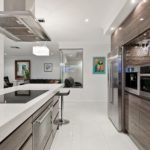 |
|
|---|---|---|---|
| Popular Brands | • SEKTION (IKEA) • Hampton Bay (Home Depot) • Diamond (Lowes) | • Kraftmaid • Merillat | • Varies by Location • Kitchen Magic (NE) |
| $/Linear Foot* | $70+ | $150+ | $500+ |
| Warranty Period | • SEKTION – 25 years • Hampton Bay - Lifetime (non-transferable) • Diamond – Lifetime (non-transferable) | • Kraftmaid – Lifetime (non-transferable) • Merillat – Various (25 years to Lifetime) | Varies by manufacturer |
| Pros | • Low Cost • Fast Delivery • Good Value | • More styles & sizes • Customizable features & accessories • Solid wood doors | • Can be fully customizable to your kitchen space • Best fit possible (custom) • Fully utilize space (custom) • One of a kind |
| Cons | • Limited styles / sizes • Particleboard Box construction • RTA requires long assembly times | • Longer lead time (30+ days) • Standard box sizes limit customization • Lower end may use particleboard boxes | • Highest cost • Longest lead time (months) |
| Best for... | Most rentals. Affordable and fast cabinet install. Choose higher quality brands to maximize value. | High-end rentals or when selling. When you want a custom-look for less. | Selling a high end home and you are asking for top dollar. |
* $/Linear Foot from Consumer Reports Kitchen Cabinet Buying Guide
Kitchen cabinets will consume about half of your kitchen renovation budget so choose wisely. It’s easy to overspend on cabinets so know your target market and stick to your budget.
Stock Cabinets – The Way To Go For Most Rentals
 Stock cabinets are the ones you see at Home Depot or Lowes in the cabinet aisle. They come pre-assembled so they don’t keep too many in the stores. You usually have to order them from the warehouse but they are in stock so they will ship quickly. IKEA (SEKTION) stock cabinets come Ready-To-Assemble. They come flat-packed and ship within a few days of your order even during their busy Kitchen Events.
Stock cabinets are the ones you see at Home Depot or Lowes in the cabinet aisle. They come pre-assembled so they don’t keep too many in the stores. You usually have to order them from the warehouse but they are in stock so they will ship quickly. IKEA (SEKTION) stock cabinets come Ready-To-Assemble. They come flat-packed and ship within a few days of your order even during their busy Kitchen Events.
Most stock cabinets are frameless. This means you don’t see the cabinet box behind the front door. This gives you an extra 10% of space versus framed cabinets. However, it also makes them a little weaker according to some custom cabinet maker sites I visited.
Stock cabinets come in set widths and depths – no modifications. You will use filler pieces to close any gaps. IKEA sizes differ slightly from other major American cabinet brands. SEKTION cabinets are 15” deep versus the standard 12” and go up to 40” tall versus 39”. This gives your tenant a lot more cabinet space. Highlight this in your walkthroughs.
If you decide to go with IKEA cabinets you may get some frowny faces from some contractors. They don’t like the assembly time. Be prepared to haggle on the labor costs or save the money and assemble them yourself.
Semi-Custom – Best For Selling Or Very High End Rentals
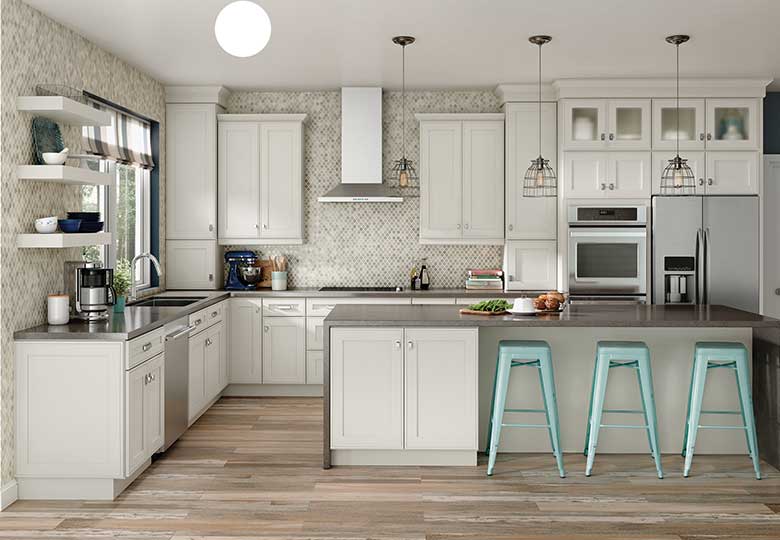
Semi-Custom cabinets offer the best of both stock and custom cabinets but you need to be careful in what you choose. Be sure you choose one that uses solid wood and plywood materials if you are looking for something sturdier. Many of the semi–custom cabinet boxes come in the same particle board construction as their stock counterparts.
The main difference beyond the box construction is the ability to make some customizations. You can adjust some of the sizes, choose from more finishes, and add features such as crown molding or pull out shelves. Home Decorators has a good reference chart to see what can vary when choosing Semi-Custom cabinets.
These will take at least 30 days to deliver so be sure to factor the extra vacancy into your ROI analysis.
The bottom line is that you should only be looking at semi-custom cabinets if you have a very high-end rental or are planning to sell your property for top dollar. Most stock cabinets will suffice even for a resale. The end product will look great and your prospective buyer probably won’t miss the extra features.
 Space is at a premium in my condo and I know tenants and buyers will value every nook and cranny I can give them.
Space is at a premium in my condo and I know tenants and buyers will value every nook and cranny I can give them.
Speaking of nooks & crannies…I lived in this condo for years and only discovered this little cabinet nook during demolition! I thought it was a fake panel. Turns out it was just really stuck.
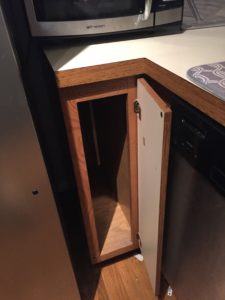
My wife wasn’t thrilled when I explained we had an extra 2.1 cubic feet of unused storage space the whole time we lived there.
Custom – Fuhgeddaboudit

Custom cabinets? Fuhgeddaboudit! That’s Jersey for “are you crazy?” There is no need for custom cabinets in a rental. Ever. You will not get a return on your investment. I don’t recommend them when selling either. Unless you are going for a million dollar listing, semi-custom will do the job.
What About Satisfaction And Quality?
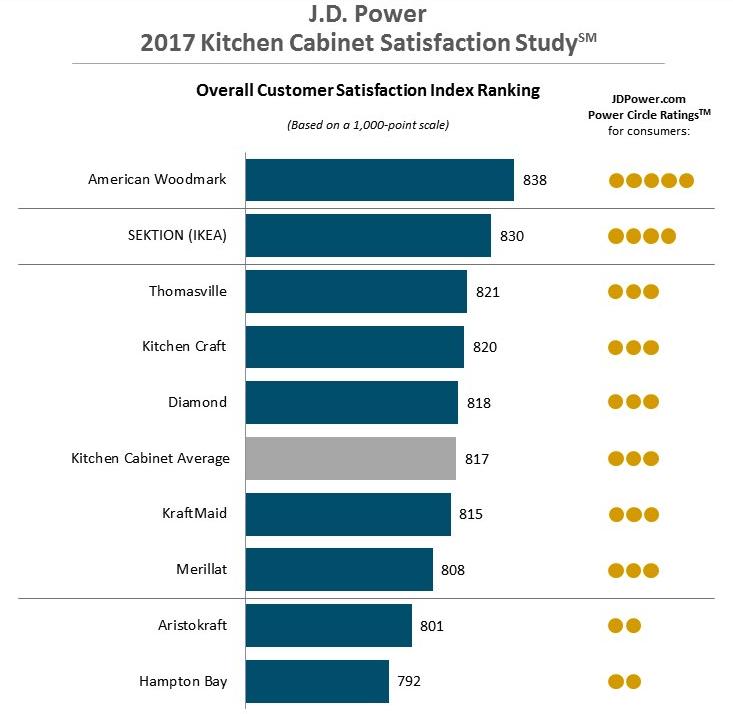
JD Power’s 2017 Kitchen Cabinet Satisfaction Study ranks American Woodmark and SEKTION (IKEA) as among the highest satisfied customers. This is based on a combination of factors including delivery, price and performance.
Caution when using this to make your decision as it is a survey of new kitchen cabinet buyers. The true test of satisfaction is 10-15 years down the road.
Further Reading
Here’s a great kitchen cabinet buying guide for more information.

Countertops
Granite | Quartz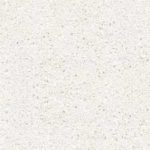 | Laminate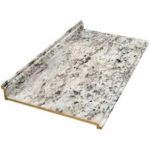 |
|
|---|---|---|---|
| $ per SF Installed | $40 - $100 | $40 - $100 | $10 - $40 |
| Max Useful Life | 100+ Years | 100+ Years | 20 - 30 Years |
| Pros | • Resist Scratches and Heat • High-end look • Variety | • Resist Scratches and Heat • More durable than natural stone • Non porous (less bacteria) | • Variety • Low Cost • Easy Install |
| Cons | • Slightly Porous • Needs to be resealed | • Fewer color choices and fewer “veins” | • Easily damaged with sharp objects • Can be burned or scorched • Limits choice of sinks |
| Best when... | Selling to homebuyer | Selling to homebuyer or Renting in high-end market | Renting in a mid to low end market |
* Maximum useful life when properly maintained according to a survey of manufacturers and researchers. (You know your tenants won’t properly maintain this so take this as a relative rating only!) Images from HomeDepot.com
Granite. The New Normal For Rentals.
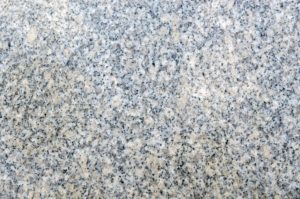 These days even mid-level rentals are coming standard with granite countertops. They have become affordable for landlords and are appealing for renters. Therefore, they can be a good choice for either home selling or renting. And because they come in a variety of colors, you can easily find something that works with your design.
These days even mid-level rentals are coming standard with granite countertops. They have become affordable for landlords and are appealing for renters. Therefore, they can be a good choice for either home selling or renting. And because they come in a variety of colors, you can easily find something that works with your design.
While they have become more affordable than in the past, they still will run upwards of $40 per square foot or more installed. This puts them out of reach for some rental renovation budgets. You should also consider the bump in equity installing a granite countertop will give you when you do go to sell.
Despite its look and value-adding capability, I generally don’t recommend granite countertops for a rental because they do require maintenance. Granite manufacturers generally recommended that you re-seal your granite countertops annually with a re-sealer like this one from Granite Gold.
You can schedule the maintenance yourself or you can hope that your tenants will do it. Either way, it really should be done to preserve the quality of the granite countertop.
For this reason alone, I recommend going with the quartz countertop in a rental if you can afford it.
Quartz Countertops. Best Option For Selling Or Renting A Property
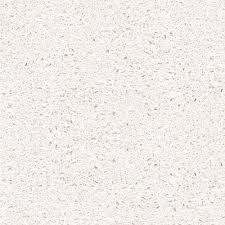 Quartz countertops are the man-made version of a granite countertop. It’s a little stronger and a little more durable than granite. It will also stand up to heat and scratches better.
Quartz countertops are the man-made version of a granite countertop. It’s a little stronger and a little more durable than granite. It will also stand up to heat and scratches better.
Quartz is also non-porous, unlike a granite countertop, so it never has to be sealed. This also means it is more hygienic.
The only real downside to a quartz countertop is the fact that it comes in fewer styles and is more plain-looking than granite. This wasn’t a big problem for me as the styles available fit my design perfectly.
Quartz is a perfect choice for a higher-end rental or when selling your property. It will have broad appeal among both target markets. And best of all, it can withstand tenant abuse better.
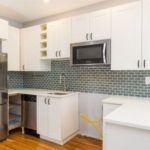
Laminate Countertops. A Great Choice For Rentals.
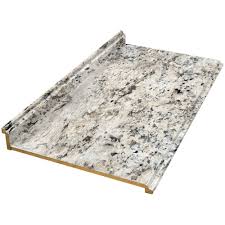 Laminate is made up of plastic adhered to particle board. They are made to look like natural stone. Most laminate countertops look pretty much like granite from a distance.
Laminate is made up of plastic adhered to particle board. They are made to look like natural stone. Most laminate countertops look pretty much like granite from a distance.
However, laminate countertops won’t last nearly as long as a natural stone or quartz. But most laminate’s can easily last 20 to 30 years or more. They can resist most tenant wear and tear. Be careful because laminate can be cut and burned, so you have to warn your tenants.
Laminate is easily installed so it will save you time and money. It’s also relatively easy to have repaired if the tenant does damage a section.
Overall, laminate’s affordability and relatively long durability make a great value for most rental property kitchen renovation budgets. Unless you are marketing a high-end rental or your market is saturated with natural stone listings, laminate can work for most rentals.
Further Reading
If you are into the science of countertops and want to learn more, check out this article.
Floors
Tile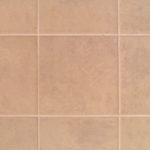 | Laminate | Vinyl (LVP)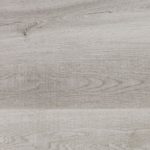 | Hardwood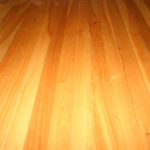 |
|
|---|---|---|---|---|
| Max Useful Life* | 50 Years | 25 Years | 10 Years | 50 Years |
| $ per SF Installed** | $5 - $15 | $2 - $6 | $3 - $7 | $5 - $10 |
| Pros | • Waterproof • Durable • Inexpensive • Tons of options | • Easy install • Inexpensive • Stain/Scratch resistant | • Modest price • Tons of styles • Easy to install • OK for damp areas • Stain/Scratch resistant | • Durable • Can be refinished • Improves value |
| Cons | • Easily cracked • Not easy to repair • Dingy grout • Skilled installation | • Can chip • Not waterproof • Fake-looking • Can't repair | • Can be damaged by sharp objects • Costs more for better durability | • Fades in sunlight • Can be scratched • Not good for damp areas • Skillful installation |
| Ease of Cleaning | Moderate. Grout needs to be touched up. | Stain resistant and maintenance free. Don’t let spills stand. | Stain resistant and maintenance free. | Moderate. Need to keep a debris-free surface. |
| Best for... | Rental Property Kitchens | Dry areas. Avoid Rental Property Kitchens. | Rental Property Kitchens | Dry areas. Maybe suited for Kitchen area if selling. |
* Per the Tile Council of America’s Life Cycle Cost Analysis
** Per Consumer Reports Flooring Buying Guide
Laminate image from Wikimedia Commons and LVP image from HomeDepot.com
Tile Can Be Great For Rental Property Kitchens
Tile can be an affordable and durable option. Choose porcelain tile if you are concerned about impact damage from tenants. A proper installation is important to avoid cracks. With so many styles and price points, you will be able to find something that fits your budget and makes your rental look great.
Avoid Laminates For Rental Property Kitchens
Don’t be seduced by the low cost and ease of installation. Laminate is made of wood fibers and will absorb water if left on the surface. While laminate floors can be repaired if chipped, it needs to be replaced once the surface layer wears out. Tile has a lower cost per year and may be a better choice.
Luxury Vinyl Plank Is The Future
Luxury Vinyl Plank tiles (LVP) are superior to older vinyl tiles. They are easily installed so you can save a lot of money if you DIY. Luxury Vinyl Planks can also be installed directly over existing floors so no need for a messy demo.
They are easy to clean and resist water so you can use them in a rental property kitchen. They don’t have as long of a useful as tile, hardwood or even some laminates so you will want to pay a little more for a thicker wear layer.
The bottom line is that LVP looks great and will stand up to tenant abuse so you will both love them.
Hardwood Can Be A Smart Choice For A Rental Kitchen (Sometimes)
Nothing beats the durability, warmth and look of hardwood floors but they can be problematic in the kitchen.
I would avoid them for most rental property kitchens unless:
- You have a high-end, open-concept rental
- The kitchen is not in the basement or subject to excessive moisture
- Your target tenant is likely to treat and maintain the floors well
Outside of the above reasons, it’s best to avoid hardwoods for a rental property kitchen. If you insist, require your tenants to keep a rug in front of the sink and stove areas. These get the most traffic and spills. Better yet, buy them a couple of rugs as a welcoming gift!
However, hardwood floors can be a great choice when you go to sell your property. A prospective buyer will be attracted by the look and appreciate the fact that they can customize it years later for minimal cost.
CASE STUDY – I chose to refinish the hardwood floors throughout my rental. It’s less than 600 SF, so it wasn’t expensive. What do you think?

Kitchen Sinks. Stainless Is Best.
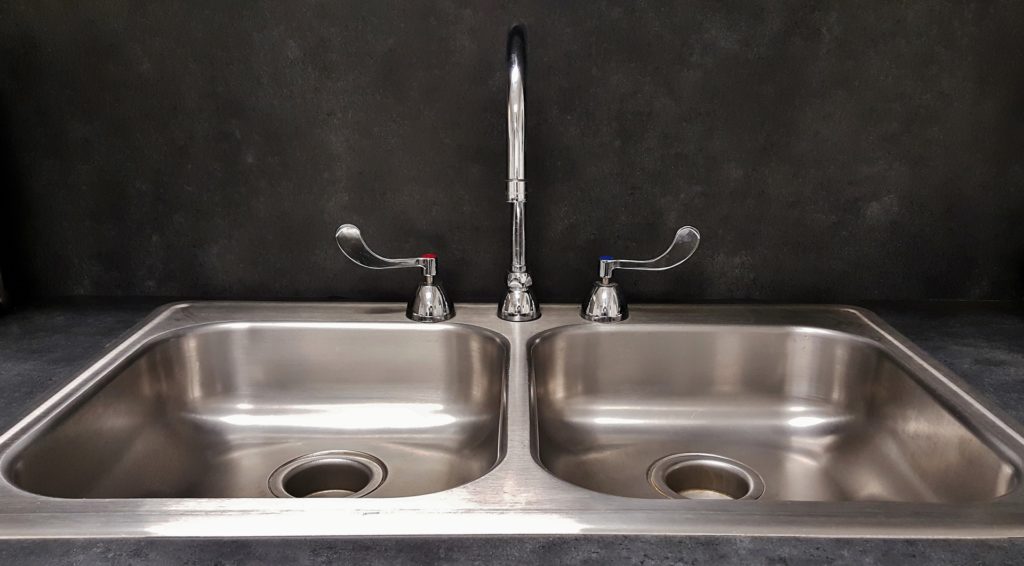
An under-mount stainless steel sinks will provide a sleek look and durable finish for your rental property kitchen.
Stainless Steel is going to be your best bet for a rental property kitchen sink. It will hold up to heat and dropping heavy or sharp objects. The only downside is that they are noisy or when you run water. Get the kind with sound absorbing pads underneath to minimize this issue.
Enamel can be a good choice if you are selling your property. Enamel comes in a wide variety of colors allowing you to customize the look of your kitchen so you can stand out among the competition. Beware however, enamel can chip or crack. When it does, it can cause rusting on the steel underneath.
Kitchen Faucet – Avoid Anything Too Cheap Or Too Fancy

For A Rental
Avoid anything too cheap or too fancy. It will cost you more in maintenance visits and repairs in the long run. Choose a mid-level faucet available at Home Depot or Lowe’s. Do not opt for a sprayer. They tend to break easily and your tenants won’t ever miss it. Also avoid anything high-end with touchless controls.
Look for brands that offer lifetime warranty and have readily available replacement parts such as cartridges. You can make a faucet last indefinitely as long as you can find the replacement parts.
When Selling
Depending on your market and your target buyer, it maybe worth investing in a higher-end faucet. This will help you stand out against the competition. Go ahead and splurge for the pull down, touchless premium model if it fits your budget.
Back Splashes – Add Value For Renters And Buyers Alike
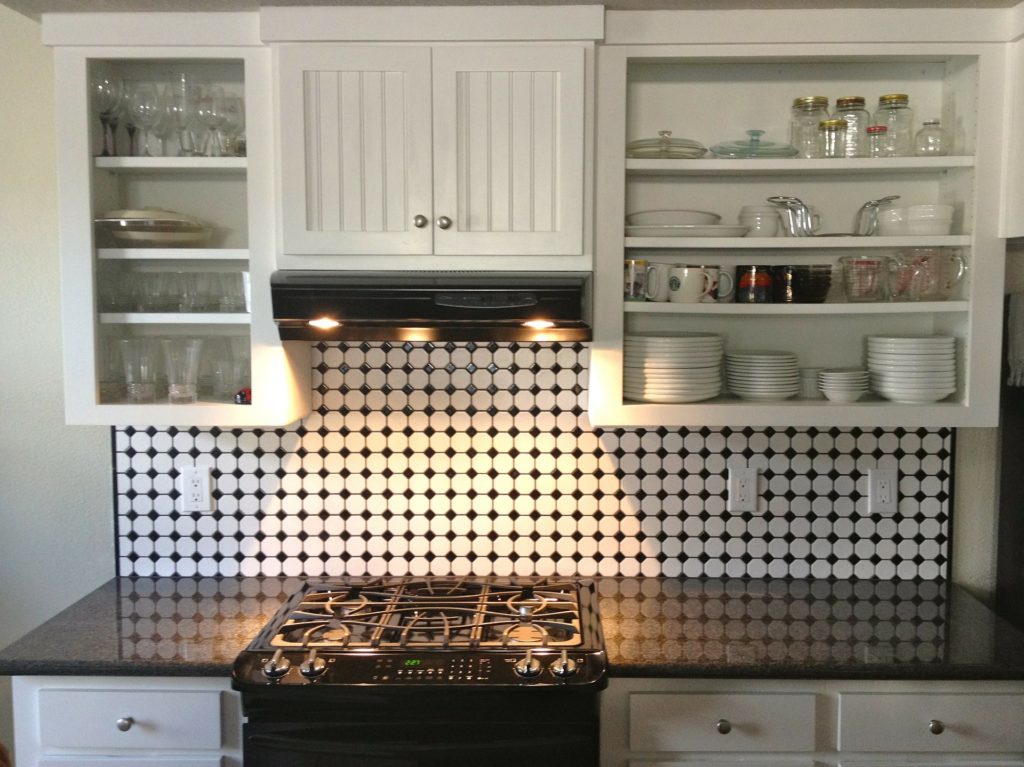
Back splashes are underrated when it comes to rental properties. Not only do they create an easy-to-clean surface for messy tenants, but they also provide an improved aesthetic value. This can help you rent your property quicker.
Whatever material you choose, be sure it is easy to clean like ceramic tile or even glass tile. Apply grout sealer to ensure a stain-resistant backsplash. For really tough grease you can use a handheld Steam Cleaner to loosen up the grease and simply wipe away.
You can use the backsplash as a focal point to offset white cabinets. Remember to keep the color choice neutral to appeal to the most number of renters or buyers. This will also allow you more flexibility if you want to change paint colors later.
Check out more tips on tenant-proofing a rental.
ROI Case Study – How Did I Do In My Rental Property Kitchen Renovation?
In the table below you can see how my actual expenses compared to my original budget.
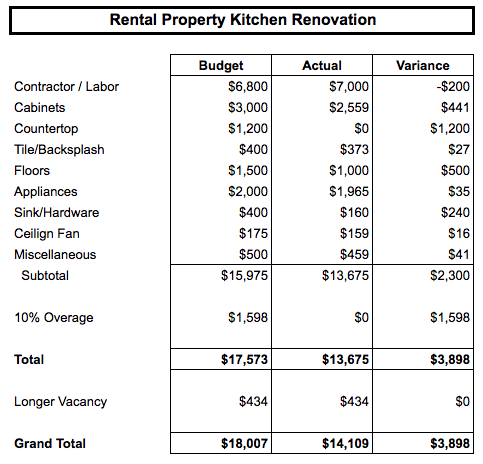
Contractor ($7,000)
This was the biggest expense for me. As I mentioned above, I didn’t want a general contractor for the whole job. My contractor quoted a single price of $7,000 to demo and install the cabinets, electrical upgrades, plumbing work and remove debris. I tried to get multiple quotes but he was actually the only guy willing to do the job for the labor only.
When I spoke with other contractors and I told them I would order the cabinets they weren’t interested. Remember they make 50% margin just for ordering the materials.
In the end though I think I got a fair price because I was able to compare this to other projects I’ve done in the same area. And I was able to negotiate the cost of the countertop in this price. That saved me about $1,200!
According to Home Advisor’s True Costs Tool, the average cabinet installation in my area costs about $5,000. My cost was higher but seems about right when you subtract the countertop, electrical and plumbing work.
Cabinets ($2,000)

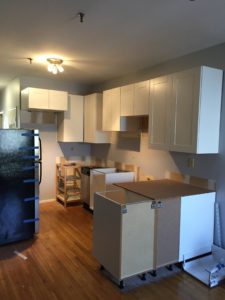
The net cost of my IKEA cabinets was about $2,000. That’s not including my $400 IKEA credit that I got from the Kitchen Event (more on this in a future article). I came in well under budget on this big-ticket item.
Appliances ($2,000)

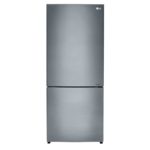
I wasn’t able to time my appliance purchases with a major holiday sales. But I still got a pretty good deal on these items. I bought a new stove and microwave range and refrigerator for less than $2,000.
I was able to design the kitchen to fit a full size oven instead of the 24″ one it had previously. This was important to attract a homebuyer eventually. These new appliances will help me rent and sell my property much quicker.
Backsplash ($350)

I budgeted a lot more for this item because the rest of the kitchen was all white. I wanted the backsplash to stand out and make an impression for both renters and homebuyers. However, in the end I went with a fairly inexpensive subway tile. I think it turned out pretty good what do you think?
Flooring ($1,000)
I had the entire condo floors refinished very inexpensively. I spent $1,000 to sand and seal about 600 SF. This is right in line with the low end of the range using the Home Advisor True Cost Tool.
Ceiling Fan ($159)

I went with this Home Decorators fan from Home Depot. I thought it was a good choice because it was sleek and had no pull chains. Tenants love to break pull chains!
It wasn’t a great choice. The remote stopped working after the second use. I am in the process of getting a new remote/receiver sent to me. I will probably spend another $75 to have someone take it down and install the new receiver.
Plumbing ($160)
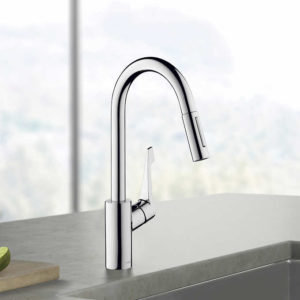
I picked up this cool looking Hansgrohe pull down model from Costco. Because I plan to sell the unit soon, I wanted something a little better than the standard rental faucet. This one is made of solid brass and had excellent reviews. I am confident it will hold up to the tenant or two.
Painting ($1,500)
I kept painting out of my ROI analysis because the rental was due to be painted again. I consider this a normal cost of tenant turnovers. If I were to include this in my ROI analysis it would’ve cost me another 1.4% percentage points of return on my investment.
I ended up spending $1,200 on the paint labor and another $300 on materials. The painter’s cost included them moving the existing fridge to my own house. No one else was willing to do it for less than $500!
According to Home Advisor’s True Costs Tool, the average painting project in my area costs about $2,000. My unit is small so I will go with the low end of the range of $1,100. Seems about right.
Miscellaneous Expenses ($459)
The total of my odds and ends ended up being just less than my budgeted $500. This included things like electrical switches, kitchen utensil holders and a fine from the city because the contractors left trash out on the curb.
Total Expenses
My total expenses came in at $13,675 vs. my budget of $17,573. I had a 10% cushion but I didn’t end up needing it. I tend to be a conservative estimator in the first place.
Extended Vacancy
My analysis also includes the lost cashflow from the extra month the property was vacant. This is a real cost of doing a renovation and needs to be part of the analysis.
Including this, I had a grand total of $14,109 in rental property kitchen renovation costs.
ROI Analysis
So what was my actual ROI? Despite some mistakes along the way, I think I did OK. I definitely learned some money saving tricks along the way that I will share with you in a future article.
Remember, I plan to hold my property for at least another year so I looked at the return on my rental property kitchen renovation project two ways.
Buy & Hold ROI Analysis
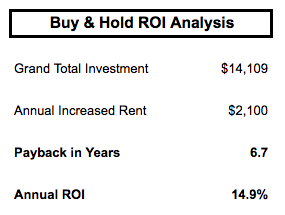
If I were to hold this rental long-term I would achieve about a 15% Return on Investment and a 6.7 Year Payback period.
I have assumed the kitchen will have a useful life of 12 years for my purposes. Why 12? Because if IKEA says the cabinets will last 25 years I’m sure my tenants can wreck it in half that time.
Overall I’m pleased with the renovation since the ROI is healthy and the Payback period is well within the kitchen’s useful life.
Note that this analysis doesn’t account for the fact that the kitchen will wear down with more tenants and won’t command a higher rent forever. Nor does it account for lower turnovers or lower maintenance expense or any of the other items mentioned above. I’ve left these out of the above Buy & Hold analysis.
I did include some of this thinking in the analysis below.
Sell Now vs. Sell Later Analysis
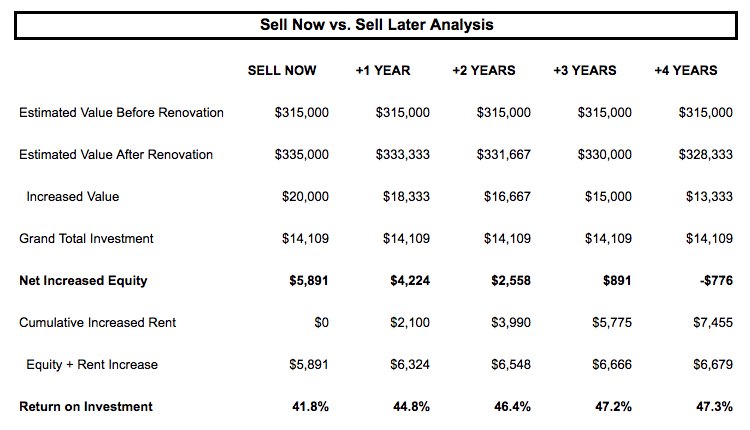
Working with my realtor and checking the comps myself, I’ve estimated that I could potentially realize an extra $20,000 (before taxes and fees) if I sell this rental property today.
That’s $5,891 instant equity ($20,000 – $14,109 = $5,891). Alternatively, it’s a 41.8% Return on Investment ($5,891 / $14,109).
But I don’t plan to sell it today.
(I actually opted to do a cash out refi and reinvest those funds. See how the numbers on my cash out refi worked out.)
Look what happens when I sell it 1 to 4 years later. My Return on Investment grows but my increased equity declines until it’s entirely gone by year 4!
Two things are happening over time.
First, the increased property value from the kitchen renovation is being reduced by the useful life (1/12 every year). If I wait only four years, then I will have spent more on the renovation than I get back when I sell it. I will start losing money on the renovation itself.
Second, the extra rent I can receive from the rental property kitchen renovation also diminishes over time. A four year old kitchen isn’t as appealing as a brand new one. I’ve assumed the extra rent will decline by 5-10% every year after the first year. So $2,100 extra rent in year one becomes $1,890 extra rent in year two. (3,990 = $2,100 + $1,890).
Hopefully now you can see why knowing your exit strategy and choosing materials smartly will help you maximize your rental property kitchen renovation ROI!
Conclusion
Taking on a rental property kitchen renovation can be intimidating. It’s not easy knowing which materials will attract top quality tenants while maximizing durability. If you are not careful, you can easily over-invest and end up subsidizing your tenant’s lifestyle.
The first step to a successful rental property renovation is understanding your exit strategy, target market and time horizon. You will need to make different trade-offs when you are improving for a tenant versus a homebuyer. The same goes for different target markets. Opt for durability over looks when marketing to a lower-end rental market.
The next step is to set your budget and stick to it. Now that you know how you will get your return on your investment, you can set a budget that will maximize your ROI. Add a minimum of 10% for overages and stick to your budget. It’s easy to get carried away and renovate as if you were going to live there. Don’t make this mistake.
Third, you will need to know how to make smart choices in your materials. Maximizing ROI is a function of maximizing the value you get from your rental property renovation. Understanding the useful life of different materials is critical. Spending a little more for better materials that will last longer may be a better choice in the long run.
Finally, you need to understand the proper way to calculate your return on your renovation investment. Include rental vacancies for a full economic analysis. Also, be sure to look at both the payback period and the expected useful life of your renovation. If your payback period exceeds the useful life, you lose money.
Hopefully you found this article helpful when planning your next rental property kitchen renovation. Stay tuned for a follow-up article about avoiding several mistakes (I made) when renovating a rental property and how to save money to ensure it pays out.
Want More Money Saving Tips?
Sign up today for the AccidentalRental.com monthly newsletter for access to more free money saving tips and tricks to being an awesome landlord!

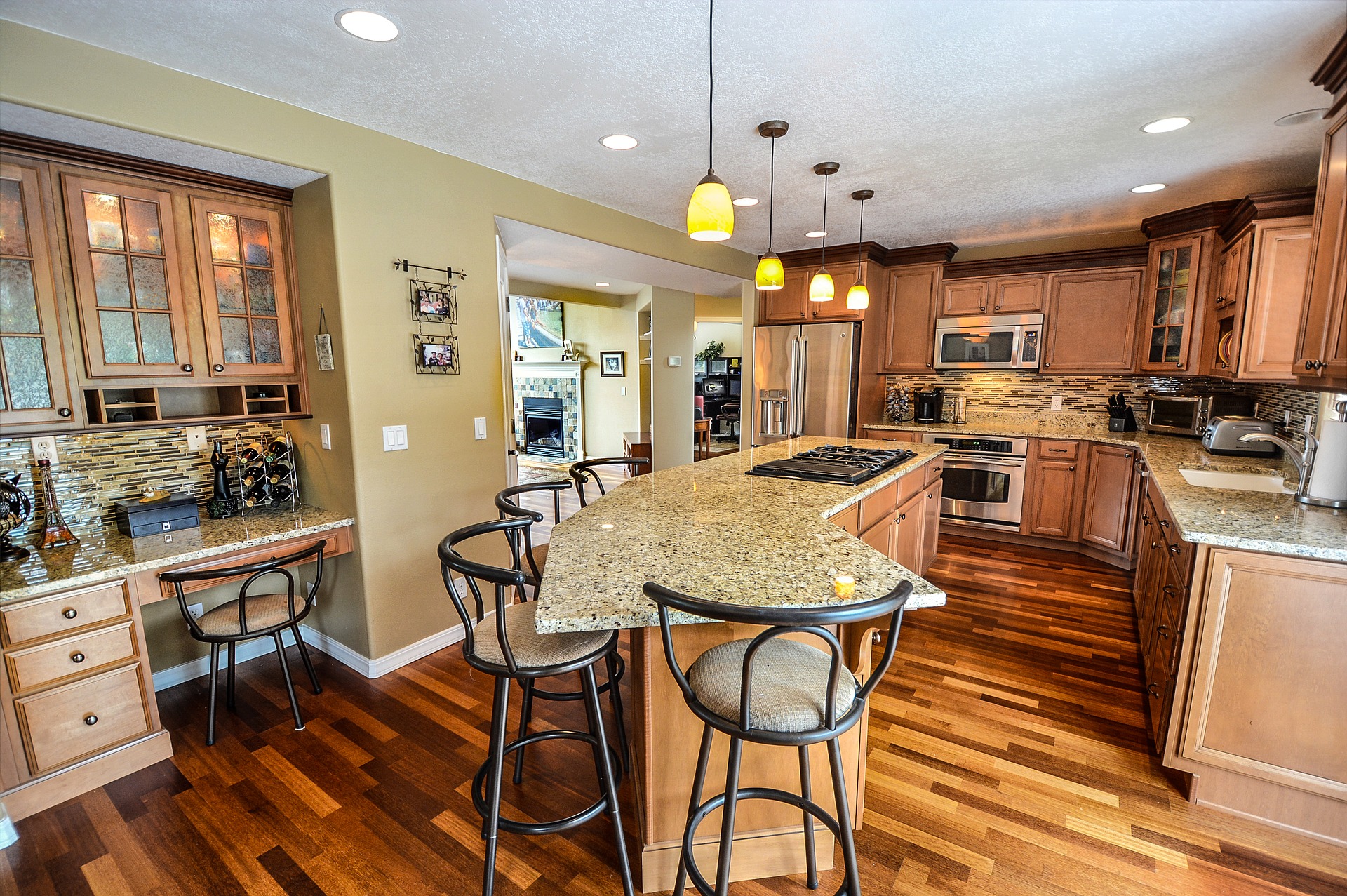

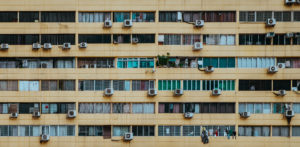
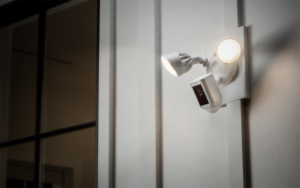
Thanks for all the helpful advice! But my question about rental property that has new carpet when it was purchase should remove it and do laminate flooring to have a open floor plan or leave the carpet for now and design according to that color? gray and white
ray and white seems to be the color choice of today. also the cabinets are in good condition but the brown color is out dated should I paint them or replace them?
Personally I wouldn’t replace a carpet if it still has more than 2 year useful life left. No need to spend money if you can avoid it. I’m assuming the carpet is in an adjacent room to the kitchen and you want the floors to flow all the way through? I would try to wait to do them all together if you can hold out. Maybe paint the cabinets now, replace them when the carpet is ready to go and you reno the kitchen/other room together. Painting cabinets is no easy project though. I would hold out or do it all together now.
I love this article, thank you! Where did you find an ROI calculator where you could compute the cost of repairs?
Thanks! I created the ROI calc myself because I wanted to compare the ROI of selling after repairs or keeping the property.
What a great article! Thank you for the comparisons of all the different materials – it is so helpful!
Pingback: 8 Renovations to Make Your Rental Property More Desirable – 4Ever Remodeling – Blog
Great article! Curious why you don’t factor in any appreciation on the property value? Also rent increases over time. Sure in the short term it’s possible you would hit a downturn, but likely over longer term appreciation is a must facor in my opinion. Thanks for all the great detailed writing!
Thanks for your comment. I consider my rentals to be very long term investments so the reality is any bump in appreciation in the short term is lost over time as the improvements depreciate. However, I would definitely include appreciation if the improvement was in anticipation of a future sale in a year or two.